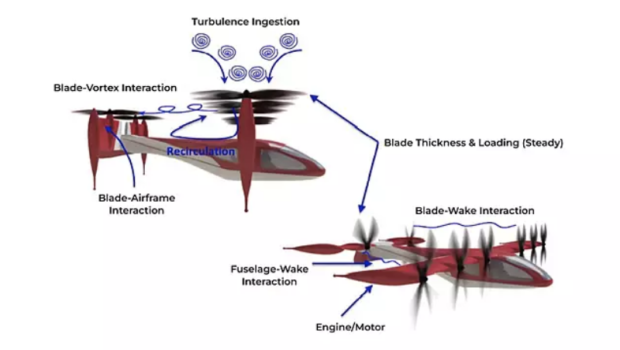Dr Arunkumar M Sampath, a Principal Consultant in Tata Consultancy Services (TCS) in Chennai, recently published a study into the implications of the increase in the production and operation of eVTOL aircraft and UAVs within populated civilian areas at relatively low altitudes which creates noise annoyance issues that impact human health and well-being.
Extract:
Advanced Air Mobility (AAM) comprising Unmanned Aerial Vehicles (UAVs) and Urban Air Mobility (UAM) with less than 100 nautical miles (nm) flying range is an emerging quick mode of transport in large cities with heavy traffic jams, where the possibility of using helicopters is ruled out due to dense population and annoying noise levels of these rotorcraft.
With significant advances in battery technology and electric propulsion, electric vertical takeoff and landing (eVTOL) aircraft form a critical role in UAM to offer sustainable transport of passengers and cargo loads in densely populated large cities around the world. An increase in the production and operation of eVTOL aircraft and UAVs within populated civilian areas at relatively low altitudes creates noise annoyance issues that impact human health and well-being.
Additionally, as eVTOL aircraft designs evolve, researchers are still assessing the types of noise and vibration sources and the means to control them for the comfort of the pilot and passengers on board.
The Federal Aviation Administration (FAA) in the USA and European Union Aviation Safety Agency (EASA) in the EU have formed working groups on Noise Vibration Harshness (NVH) to formulate strict noise regulations on UAM aircraft and ensure compliance by different eVTOL and UAM manufacturers on acceptable community noise levels (exterior noise) and pilot and passenger comfort levels during air travel (interior noise).
Different research facilities under the aegis of the National Aeronautics Space Administration (NASA) at Langley Research Centre in Hampton Virginia and Glenn Research Centre in Cleveland Ohio, have been assisting FAA in developing eVTOL aircraft concept designs, developing generic codes for predicting the performance and noise signatures of these aircraft, and analysing and characterising the noise generated by these vehicles.
Owing to multiple sources of noise in an eVTOL aircraft generating tonal, narrowband, and broadband noises under different flight modes of operation, efforts are being made to optimise the design for noise reduction at source, improve the lightweight fuselage design for better aerodynamics, range, and NVH, and explore active noise and vibration control technologies for improved interior noise and pilot and passenger comfort.

A few concepts of UEM (eVTOL aircraft) designs have been proposed by NASA [Ref 1,], some of which are shown in Figure 1 [Ref 1] that comprise a quadrotor aircraft, with turboshaft and electric propulsion; side-by-side aircraft, with turboshaft and electric propulsion; lift + cruise aircraft with electric and turbo-electric propulsion; a quiet single-main rotor helicopter with turboshaft and electric propulsion; and a tilt-wing aircraft with turbo-electric propulsion.

